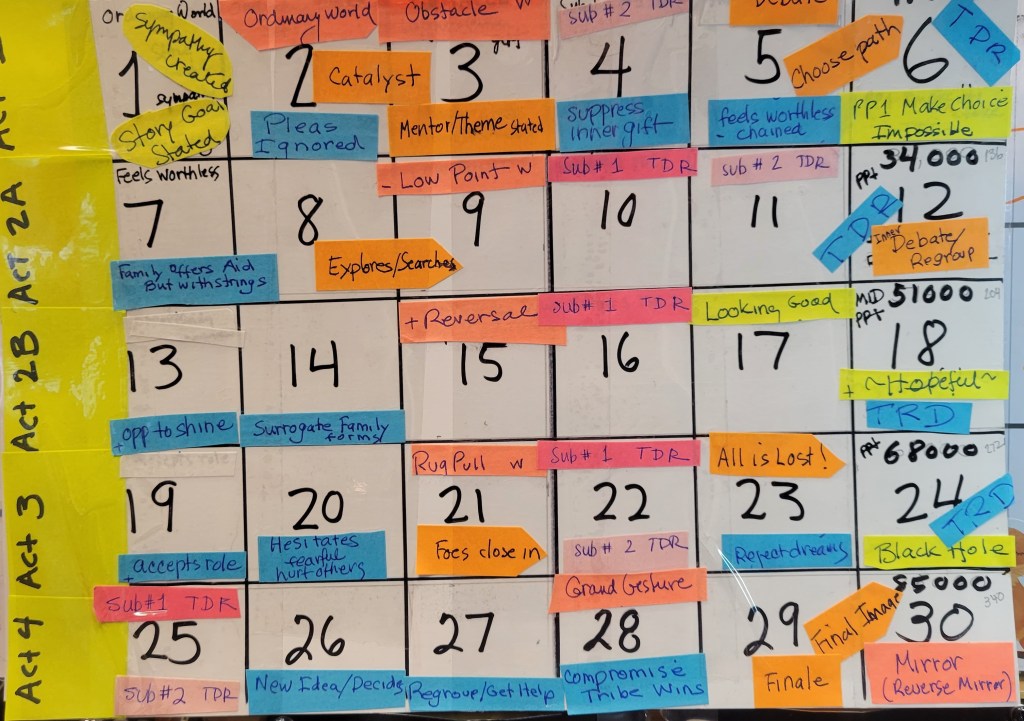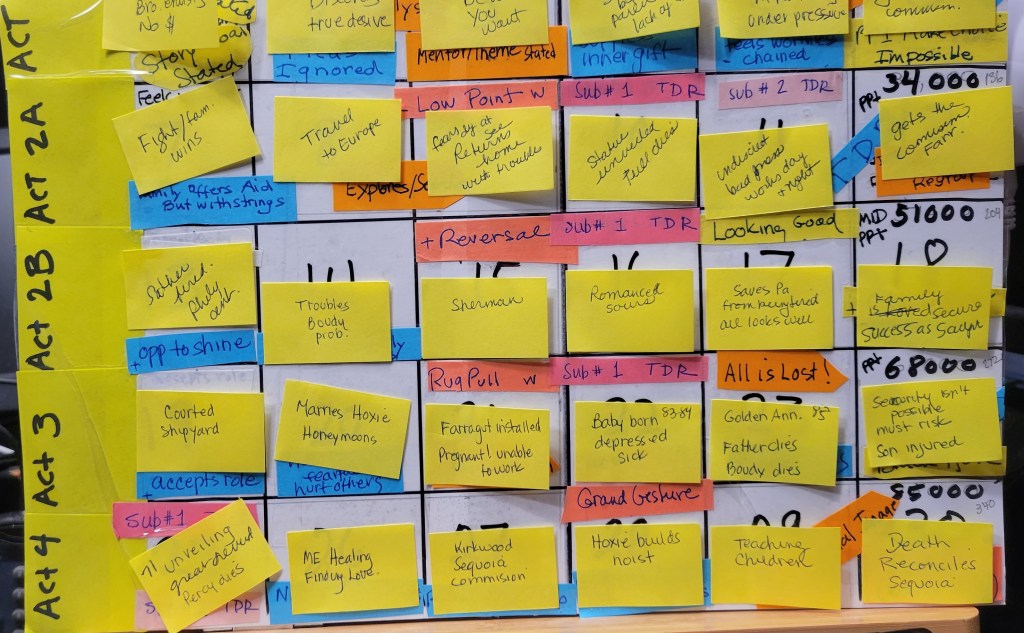Writers need every tool possible in their repertoire. Brainstorming and mind mapping are two powerful ones. Storyboarding is another. A storyboard is the compact, visual telling of a story. The idea of storyboards comes from the film industry. Each block on the board represents a scene or event. A drawing or photograph that captures the essence of the scene is placed in each space with minimal summary text.
Screenwriters rely on storyboards to plan out the order of their scenes and make sure the crux moments fall in the right locations.
Why Should Writers Use Storyboards?
Writers can also benefit from planning out their story using this visual tool. Storyboards are a quick, fluid way to plan a novel. It is a way to see how your story events flow together, how they match up with the plotting template you choose to use, and where there are plot holes.
Like brainstorming and mind mapping, a storyboard allows one’s creativity to flourish at the same time that it gives an overall picture of the entire work. Because the parts are moveable, it is easy to try out different arrangements of the story action before committing words to paper.
After you start writing, the storyboard can be consulted as a way to stay on track, or it can be changed to match new twists and turns as they occur to you.
How to Make a Basic Storyboard
A storyboard does not need to be fancy. To try out this tool, all you need is pencil and paper.
- First decide if you will be laying out scenes or chapters.
- Fold or rule off the paper into the number of squares closest to the number of scenes and/or chapters you plan on having. You can get an idea of how many you need by checking novels to similar to yours. Most genre novels range between 25 and 30, but the number is up to you and can be changed at any time.
- Number the squares.
- Fill in the squares with the actions that will be happening in your story.

In this example, I have laid out 30 chapters for a historical romance. My plan is to average 2800 words per chapter to get a complete length of 85,000 words.
Expanding the Story Board
While it is easy enough to erase and replan on a paper grid, I have found using index cards or sticky notes on a grid allows even more creative planning. The cards and notes can be quickly rearranged or replaced. Using different color cards or notes allows for visual coding.
The size of your board can range from an 8.5” by 11” sheet of typing paper to wall-sized. I like using an open file folder as I can then stand it up next to my computer when I am writing.
Using the Storyboard
Storyboards are essential for planning the pacing of your novel. Seeing the entire plot laid out visually allows you to pinpoint those scenes that need to be amped up or given more or less importance.
For example, a three-act structure works well on a story grid having four rows. Use the first row for Act 1, the setting the stage part of the story. Use row two and three for Act 2 (I often label these Act 2A and 2B, the middle half of the novel where the action takes place. The last row is Act 3 where the climax and resolution of the story happen. As far as columns go, make as many as you need to approximate the number of chapters you are planning. See my example below.

Here is a simple, twenty-four chapter plot layout storyboard suitable for most genres.
If you are using a plotting method such as the W-Plot or the three-act hero’s journey, you can label the squares where those plot points should occur to help in placing your scenes.
Where plot points are regularly spaced, the novel will flow along smoothly. When they are widely separated the story will move slowly. When close together, the action will be fast-paced.
In the following example from a novel idea I am playing around with, I have color-coded plot points using my versions of several different plotting approaches.

KEY
CORAL & YELLOW- The W-Plot
BLUE – The Heroine’s Journey based on Gail Carriger’s book of the same name.
ORANGE – Save the Cat by Blake Snyder
PINKS – Jane Cleland’s Plotting Road Map secondary plots
Once you have a plotting outline you like, consider laminating it so you can reuse it for several novels. I covered mine in clear packing tape.

Here is my working storyboard for this year’s NaNoWri Mo novel with my very sloppy sticky notes.
Digital Storyboards
One benefit to using a computer program is that it is much easier to add visuals – something my examples above lack.
There are several ways to create a storyboard using the computer.
One: Use a word processor or presentation program like PowerPoint. Create a grid using the Table feature and then type in your scene or chapter information. Visuals can then be added.
Two: Use a free template available on Canva. Canva has many photos and symbols you can add.
Three: Use Trello. Trello is a free index card type program. You can put visuals and quite a lot of information on each digital card. These can be moved around and rearranged easily.
Four: Use the scene card feature found in Scrivener.
Five: Use Plotrr. This online application has a built-in plotting board.

Here is a very simple Canva-created storyboard.
The Power of Storyboarding
No matter how you make your storyboard, summarizing the components of a complex work into a series of blocks delineated by a few pertinent words and/or a visual helps the brain see the whole in a way that is not possible in a linear listing of ideas or an outline. I never write a book without a storyboard by my side. Give it try and see if this is a tool you want in your writer’s toolbox.
Are you a fan of storyboarding? Any special tricks or tips?
Discover more from ZARA WEST'S JOURNAL
Subscribe to get the latest posts sent to your email.

Reblogged this on wordrefiner.
LikeLike
Love the idea of creating one in Canva.
LikeLike
Very impressive. I don’t use story boards either, but this is a fantastic guide. Thank you for sharing !!
LikeLike
I’ve never used one, but I’m saving this post and will consider in the future.
LikeLike
There are so many great planning tools for writers. This is an easy one to try. I forgot to mention that it great for revising too. You make sticky notes for each scene/chapter and then see if they fall at the right plot points.
LikeLike